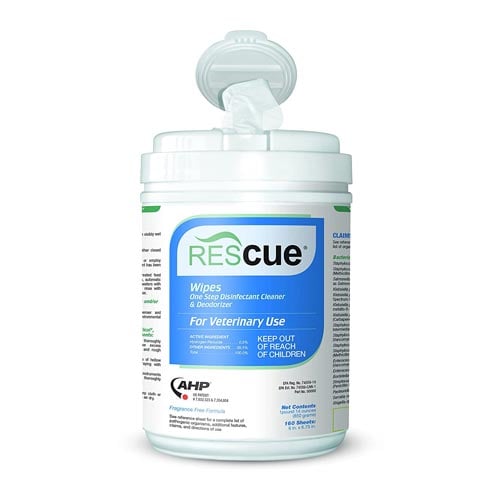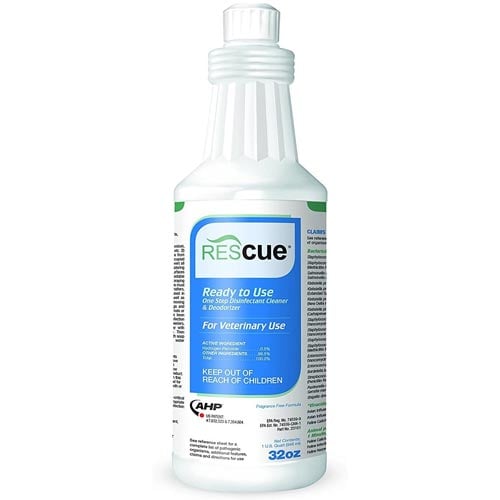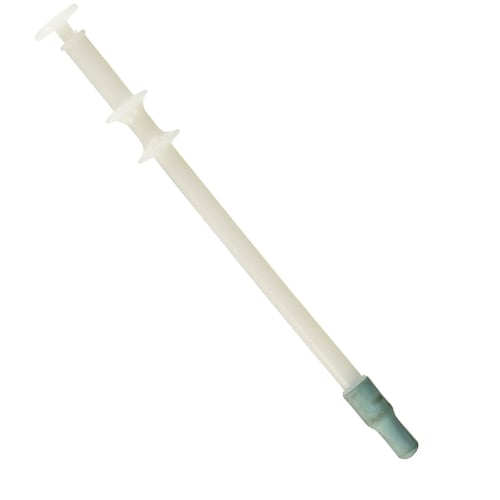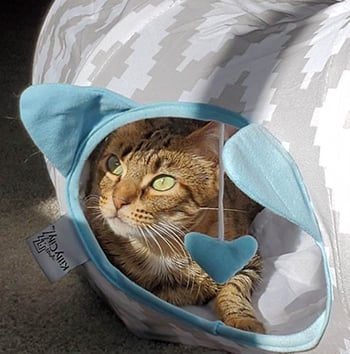
I’ve had cats my entire life. But it wasn’t until recently that I had my first experience taking a cat through recovery from a serious surgery. She was a beautiful little foster kitten named Bettina.
About a year ago, I made the decision to start fostering, focusing on cats in need of special care, either with recovery from surgery/illness or socialization issues.
Bettina was only my second foster and took considerably more intensive care than my first, who only had a cold and needed a week out of the shelter to recover. (And who, incidentally, I fell madly in love with and adopted at the end of that week.)
You’ll hear a bit about my story, successes and failures, products I found helpful, conversations I wished I’d had, and how an old bra saved the day.
My Foster Kitten’s Story
Betti (as I called her) was rescued in California after being shot with a pellet gun. She was transferred to Seattle by the amazing team at Emerald City Pet Rescue, where they assessed the damage and determined amputation of her front leg and removal of part of one lung were the best options. And that’s where I came in.
I’d actually agreed to take another foster who, at the last minute, was adopted instead. It was a double blessing. Kitty #1 got a home. And I got to care for one of the most amazing little spirits I’ve ever known, in Bettina. After a couple of months of testing and getting her healthy enough for surgery, it was time for the big event.
Different people handle things in different ways. I’ll come clean right up front. I’m a planner, a worrier, and an over-thinker. If you can relate, the idea of caring for a furball who can’t tell you what hurts or what they need is likely to cause some anxiety. Let me save you a lot of stress right now. You’re going to do the best you can, given your situation and experience. There’s no question. You’ll be great! And your fur baby is going to handle things just fine. They’re as resilient as it gets. Just trust yourself and don’t overthink it.
I’m pretty sure I made recovery even more stressful (on me and my kitty patient) by constantly trying to find a “better” solution, make her more comfortable, give her easier access to a bed or litter box. My intentions were good. I was just so afraid of missing any little thing that could help her heal (physically and emotionally) that I overdid it.
Maybe I’m being a little dramatic. I didn’t hinder her healing process. But I certainly got a lot of those looks that said, “Mom, stop messing with my blanket. No, the other water bowl isn’t any better than this one. Yes, I’m still breathing. PLEASE just let me sleep!” I may have driven her batty (which, ironically, was another of her nicknames). And I definitely stressed myself out more than I needed to.
The upside is that I powered my way through a lot of trial-and-error and have some tips that are certain to save you and your furry patient a little time, money, and stress if you’re preparing for a surgery.
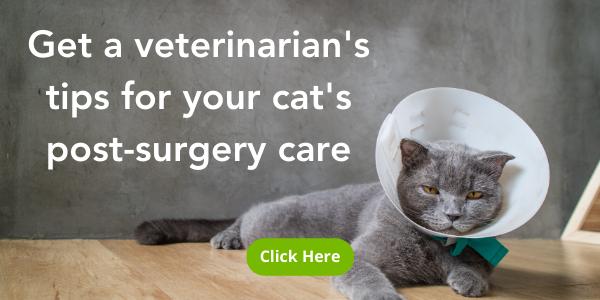
Setting Up Your Cat’s Recovery Space
First and foremost, ask your veterinarian (or, in my case, foster care team) for clear post-surgery instructions well in advance of the procedure. I set up a special room dedicated to kitty recovery – naively expecting she’d relax in her favorite chair all day and we’d sleep together at night, waking up refreshed and cuddling every morning – only to learn, upon picking her up, that she needed three weeks of complete bed rest. Not a whole room, but a crate where she was forced to stay off her feet (which now numbered three instead of four).
This threw my plan out the window and added unnecessary stress for both Betti and me, as I struggled to create a new setup on the fly, while she was stuck in her carrier.
The thought of restricting my cat to a large crate, with a tiny litter box and a cone stuck on her head, while she was dealing with the loss of a limb, was awful for me. I needed another option that provided the physical restrictions she needed, but also took into account her emotional needs (and let’s be honest, mine too).
While cats do need a quiet, safe space to recover, a dark, solitary cage wasn’t the healing space I wanted for her. Luckily, I found two great options that changed everything.
Use a Portable Kitty Pen
If you have young kittens (or really any small critter that can’t jump too high or throw a lot of weight around), try a convertible option like the Songmics Pet Playpen. It’s made of transparent plastic panels and simple plastic connectors, giving you the flexibility to create whatever style enclosure you need.

Songmics Pet Playpen
Buy on Amazon
It’s essentially a “build-your-own” option. You can combine panels to create high walls or stick with a single panel shorter wall. The same panels can also be inserted as dividers within the enclosure if you want to keep food and water separate from the litter box or bed. Enclosure size is entirely up to you. You can build it with a floor if you need to protect your own floor. The possibilities are endless.
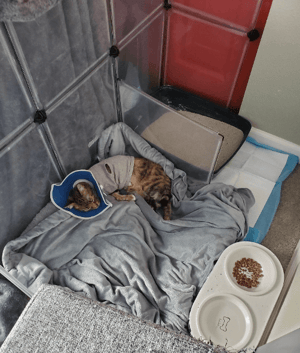 Bettina in her Songmics recovery enclosure. I used one panel to separate her litter box from her resting area.
Bettina in her Songmics recovery enclosure. I used one panel to separate her litter box from her resting area.
I should also mention that it’s easily disinfected, which is vital if you care for animals with viruses that can be shared, like respiratory infections or feline leukemia. I recommend just keeping one on hand.
I’ve used mine in so many unexpected ways, from walling off a section of the closet I needed to keep kitties out of, to a makeshift litter box enclosure, to a cozy hideaway for my new fosters. It’s a great, versatile tool if you have small critters of any kind.
Another of my foster cats with the Songmics panels set up with a floor and open top.
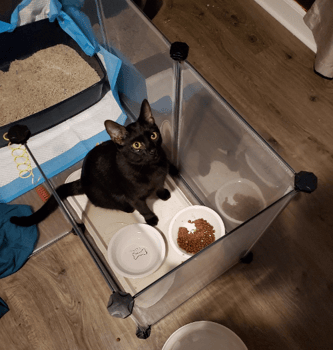
The real life-changer for this particular recovery was the ESK Collection Pet Exercise Pen. You’d think, after losing a leg and a bit of lung, my foster cat would have been down for the count, at least for a while. But no! Within two days, she was ready to try out her new body.
While the medication, prescribed by her veterinarian, helped mellow her out – and she spent plenty of time resting – I couldn’t rely on my homemade barriers to keep her down for long.
I wanted an enclosure that would give her room to take a few steps while still forcing her to rest. I also wanted a space that allowed for a decent-sized litter box and food and water bowls that wouldn’t be constantly spilled.
Most importantly, I didn’t want her in a dark, stuffy box. She needed light, fresh air, the ability to see what was happening in the room.
Mental healing is as important as physical healing. And it was essential, for my peace of mind, to be able to see her easily, reach in for cuddles, and move her from room to room as I went about my day. This ESK Pen was the answer.
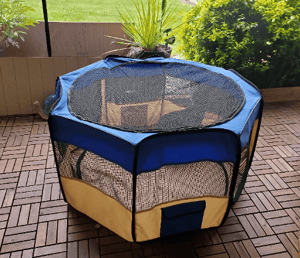
ESK Collection Pet Exercise Kennel
Buy on Amazon
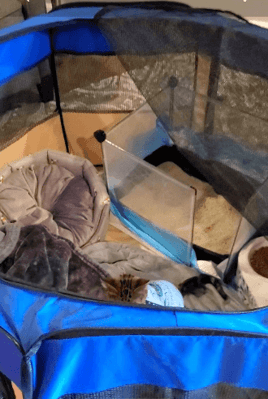
I was even able to use a few of the panels from my Songmics Pet Playpen to create a separate space in the ESK Pen for the litter box, cutting down on the mess and clean-up time. And now I use the ESK on my patio as a way for my other cats to spend time safely outside. It’s been a great product!
My only caution is to remember it’s made from fabric and wire, meant to be collapsible, not only when you choose to collapse it, but also when your other cat decides to jump right in the middle of it. These materials also mean it's a bit more of a chore to fully disinfect, compared to the Songmics panels. So be aware.
Admittedly, I’m in the unique situation of having a one-person household and working from home. That’s one of the reasons I chose to take on these types of foster cases. But even if you’re dealing with an active household, both of these options would work for you.
They can be covered with a blanket for kitty quiet time. They also provide some protection from other animals in your home who may be overly curious. They are easily moved into quieter rooms throughout the day, as home traffic patterns change. The openness and visibility into the enclosures are particularly handy if you want to keep them in a separate, quiet room but need to be able to check in often without disturbing them.
PRO TIP: Keep your cat's recovery space clean and disinfected with veterinarian-recommended Rescue Wipes. The wipes are great for small spaces or for disinfecting individual items, while the liquid spray makes cleaning larger areas easier.
Alternatives to the “Cone of Shame”
I’ve seen videos of dogs and cats happily (albeit somewhat annoyed) going about post-surgery life in the dreaded cone with no worries. That was not the case for my little foster. It was immediately clear the cone was causing emotional distress. Whatever the cat equivalent of depression is, she must have had it. She just looked so sad and defeated. But as soon as I’d take the cone off, her eyes would light up again, and her spirits would lift. I hated making her wear it. And it wasn’t providing the comfort she needed.
I made the decision to find other solutions to protect her incision and limit her time in the cone. If the cone works for your cat, save yourself some stress and stick with it. The time to help your cat feel comfortable with their cone is BEFORE they need to wear it, not after the surgery.
Ask your veterinarian to get you a cone prior to the surgery date – give yourself 2–3 weeks to prep your cat. You can read some tips on how to help them feel better about wearing a cone in this article: “Your Cat in a Cone: Elizabethan Collar Desensitization.”If you truly think your pet needs another option, here’s what I tried:
Fabric Cones
The first big issue with the standard fabric cones was the litter box. She couldn’t lift her head high enough to keep them out of the litter. So, she’d end up with a cone full of the stuff after every trip to the box. Gross factor aside, that’s not good for kitty (or mom who wants to cuddle kitty).
The second issue was the location of the incision – in our case, chest, shoulder, and front mid-section. The cone didn’t keep those back feet from trying to scratch. I tried different sizes, cutting them down, turning them inside out, and backwards. Nothing worked. Of course, if your incision is in a different location, you may be just fine. But don’t be afraid to experiment with different styles and sizes.
Inflatable Collar
Next, I tried the inflatable collar. Again, it was the incision location that was the issue. The collar rubbed the incision near the neck, and she could still scratch with her back feet. I’ve used the inflatable in other situations successfully. But here, it wasn’t right.
Surgical Suits
Then I moved on to the recovery suit. If you’re not familiar, it’s essentially a onesie for animals. I think it would work well for an incision that couldn’t be reached by the back feet. But in our case, she was able to scratch her wound, and the suit fabric wasn’t thick enough to protect against those claws. The suit is made to breathe. Good for healing, bad for kitty nails.
DIY Cat Cone Alternative
What finally worked? I basically needed a t-shirt with padding along the left shoulder and chest. The vet had sent her home in a little pet t-shirt used to provide some extra warmth post-surgery. Unfortunately, the left armhole exposed her incision site. So, I channeled my incredibly inventive mother and got creative!
I sewed the left armhole of the t-shirt closed, pulled the pad out of an old bra (yes, my old bra), and, with a little cutting to shape, sewed it on the outside of the t-shirt over her incision area. Not only was it thick enough to stop the back claws from doing damage, the cup shape meant that it wouldn’t rub on the wound. I promise I ran this past my foster care team. They were OK with it, providing I kept it clean and removed it throughout the day so the incision could breathe. I still had to watch her like a hawk, or she’d find a way to do damage with those long back legs. But the t-shirt certainly helped.
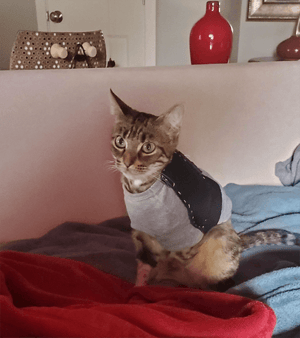
Bettina in the DIY padded recovery shirt.
Of course, there are plenty of other padded materials that would work just as well, if not better. It was a desperate time, a desperate measures situation. But always check with your veterinarian to be sure your empathy and creativity aren’t doing more harm than good.
The moral of the story: Sometimes, the right mix of ingenuity, impaired judgement from lack of sleep, and a good sewing kit are all you need to solve a problem. But be sure to check with your veterinarian before modifying your aftercare plan. They’re the experts! What you know is your cat’s living arrangements and your ability to cater to them, so be sure to give as much information as possible to your vet, so they can recommend the best solution.
Post-Surgery Medication
If you have a cat that doesn’t like taking meds, this part is just unpleasant. Your vet can show you the proper way to gently persuade your cat to take a pill down. We also have some tips and tricks in our article, “Is It Hard to Give Your Pet a Pill? There Are Options” to help make the medication process easier for both you and your cat.
In my case, after two weeks, twice a day, Bettina was just flat out mad about the whole process. It’s amazing how tightly a cat can clench their jaw when they want to. We had our share of hissing, growling (from both of us) and yes, a scratch or two. But I couldn’t blame her.
And if you have a cat who hates taking pills and you’ve never seen a pill popper tool, get ready for a life change! Mine was provided by my vet. But you can buy them online as well. It’s a syringe that allows you to load the pill in one end and shoot it into the back of the throat with the plunger. Particularly for cats, giving pills can be rough.
This gadget is a huge help. You need to follow up with a syringe full of water to encourage them to swallow and help avoid the pill getting stuck in their throat. There are a few different low-stress and fear-free ways to give a cat medication. Watch this video for one way to safely pill a cat using a pill gun:
PRO TIP: If your cat's medication is a cut tablet, you can place the cut tablet in an empty #3 gel capsule. That way they do not get exposed to the bad taste of the medication that is present once the enteric coat of the tablet is broken (which happens when the tablet is cut).
What to Ask Your Veterinarian Before Surgery?
I strongly suggest spending some time talking to your vet about medications before the surgery. When you pick up your little fluff, you’ll be bombarded with a ton of information. If you can get a little info beforehand, pick up and the aftermath will be less stressful.
- What physical effects each medication will have? It matters more than you realize. For example, if your cat will be knocked out and need help getting to the litter box, you may need to change your set up or make sure you’re not gone for extended periods. It’s also important to be aware of potential personality changes. Bettina had been on a pain killer since she was first rescued by the shelter, all the way through her surgery and recovery. It wasn’t until after surgery, when she finished the medication, that the foster staff and I realized her obsessive need to cuddle was actually a side effect of the meds. So, it’s good to know what to expect and, just as important, what’s considered abnormal and should raise a red flag.
- What are your medication options to help keep your cat relax and be less active? I was really struggling to keep Betti mellow after the first couple of weeks. I finally mentioned it to my vet, and he suggested simply upping the dosage of one her existing medications to sedate her a bit more. While you don’t want to overmedicate, being able to increase a dosage was well worth it if it meant less time she’d have to be in a confined space. Always check with your veterinarian when it comes to your pet’s medication. You should never increase (or decrease) your cat’s medication dosage without your veterinarian’s approval.
- What are the correct dosages for each medication? I also suggest reading the dosage instructions back to the vet to make sure you’re clear. I had a near miss with instructions on a liquid medication because the decimal point was difficult to see, making .1 look like 1 to my untrained eye.
- What are the after-care instructions? Knowing this ahead of time makes it a lot easier to prepare. A perfect example is when I picked Bettina up after her surgery and only then learned that she needed to be confined to a small area, like a dog crate, so she would stay off her feet instead of a whole room as I had planned. Coming up with a solution then, instead of ahead of time, caused stress that just wasn't necessary.
Take Care of the Caregiver
Being the caregiver for your pet, whether you’re seeing them through surgery, injury, illness or old age, affects everyone differently. Even short periods of caregiving can take their toll.
If there’s one piece of advice you take away from my experience, let it be this: You cannot take care of others if you don’t take care of yourself.
It’s nothing you haven’t heard before. That doesn’t mean we take it to heart – myself included. Part of my need to write this article springs from the fact that, in hindsight, I didn’t handle this process the way I wish I had. Don’t get me wrong, I did everything I could for her, and it was a wonderful experience. I was happy to sacrifice sleep, work, stress, whatever it took. But I made it harder than it needed to be.
For example, when I found out she needed bed rest and wouldn’t be able to get up and down off the mattress I’d set up for us, I slept on the floor inside the temporary enclosure. Did I feel like super mom? Heck yes! Did I feel better being right there beside her in case anything happened? Absolutely! Did I get a single good night’s sleep for two weeks? Nope. Would I have been any less of a super mom if I’d slept in a real bed next to her enclosure? Of course not. All I’m saying is take care of yourself.
Ask for Help
Don’t be afraid to ask a friend or family member for help. I was doing this solo, while simultaneously trying to introduce a new cat (the aforementioned first foster) to my permanent cat family, which wasn’t going as well as I’d hoped. I had one cat on bed rest and three trying to destroy each other. It took me way too long to realize I needed back up, even just for a few hours. People say it for a reason — it takes a village!
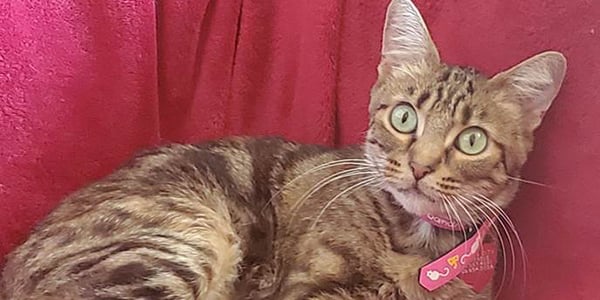
In Closing
The post-surgery experience was a rough few weeks for me. It took a while to understand why I was so consumed with giving her the best possible recovery experience. Looking back, I think I was trying to compensate for the rough start she had at life, and the difficult road she was facing. I was her first real “home,” albeit temporary, and I wanted to give her a lifetime of love during the short time she was with me.
I could have been easier on myself. Less judgmental of my decisions, more aware of what I needed, less afraid to cause Bettina any undue stress. And I could have made it easier for myself if I’d known better what to expect and what my options were to simplify things.
Plan ahead so you have the time to consider your own needs as well as your pet’s and can come up with a plan that takes care of you both. Don’t get caught off guard so you feel like you have to sleep on the floor and spend hours searching for a different cone, collar, bed, litter box, enclosure that can be delivered right away because you didn’t know exactly what you’d need.
Let’s be realistic — odds are pretty good you’ll be less of a stress ball than I was. I learned a lot from this experience, and I wouldn’t trade it for anything. Bettina recovered beautifully and was zooming around the house like a little psycho in no time. And I’m so much better prepared for my next foster.
I hope sharing this glimpse into my crazy journey gives you a little insight into what you could run into and how you can prepare. A little informed planning and a lot of love is all you need to help your best furry friend through their recovery!


